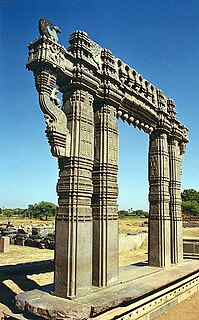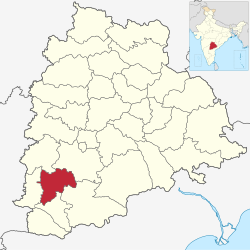
Hyderabad State, also known as Hyderabad Deccan, was a princely state located in the south-central region of India with its capital at the city of Hyderabad. It is now divided into the state of Telangana, the Hyderabad-Karnataka region of Karnataka, and the Marathwada region of Maharashtra, in present-day India.

Mahbubnagar is a city in Mahbubnagar District of the Indian state of Telangana named after the 6th Nizam, Mir Mahbub Ali Khan. It is the headquarters of Mahbub Nagar mandal in Mahbub Nagar revenue division. The city is also the largest in the district with an area of 39.64 km2 (15.31 sq mi) and 7th most populous in the state.

The Charminar constructed in 1591, is a monument and mosque located in Hyderabad, Telangana, India. The landmark has become known globally as a symbol of Hyderabad and is listed among the most recognised structures in India. It has also been officially incorporated as the Emblem of Telangana for the state of Telangana. The Charminar's long history includes the existence of a mosque on its top floor for more than 400 years. While both historically and religiously significant, it is also known for its popular and busy local markets surrounding the structure, and has become one of the most frequented tourist attractions in Hyderabad. Charminar is also a site of numerous festival celebrations, such as Eid-ul-adha and Eid al-Fitr.

The Nizams were the 18th-through-20th-century rulers of Hyderabad. Nizam of Hyderabad was the title of the monarch of the Hyderabad State. Nizam, shortened from Nizam-ul-Mulk, meaning Administrator of the Realm, was the title inherited by Asaf Jah I. He was the viceroy of the Great Mughal in the Deccan, the premier courtier in Mughal India in 1724, and the founding "Nizam of Hyderabad".

Telangana is a state in Southern India situated on the south-central stretch of the Indian peninsula on the high Deccan Plateau. It is the eleventh-largest state and the twelfth-most populated state in India with a geographical area of 112,077 km2 (43,273 sq mi) and 35,193,978 residents as per 2011 census. On 2 June 2014, the area was separated from the northwestern part of Andhra Pradesh as the newly formed state with Hyderabad as its capital. Its other major cities include Warangal, Nizamabad, Khammam, Karimnagar and Ramagundam. Telangana is bordered by the states of Maharashtra to the north, Chhattisgarh to the east, Karnataka to the west, and Andhra Pradesh to the east and south. The terrain of Telangana region consists mostly of hills, mountain ranges, and thick dense forests covering an area of 27,292 km2 (10,538 sq mi). As of 2019, the state of Telangana is divided into 33 districts.
Reddy is a caste that originated in India, predominantly settled in Andhra Pradesh and Telangana. They are classified as a forward caste.

Asaf Jah VI Sir Mir Mahboob Ali Khan Siddiqi Bayafandi was the 6th Nizam of Hyderabad. He ruled Hyderabad state, one of the Princely states in India between 1869 and 1911.

Mir Osman Ali Khan, Asaf Jah VII, was the last Nizam (ruler) of the Princely State of Hyderabad, the largest princely state in British India. He ascended the throne on 29 August 1911, at the age of 25 and ruled the Kingdom of Hyderabad between 1911 and 1948, until India annexed it. He was styled as His Exalted Highness-(H.E.H.) the Nizam of Hyderabad, and was one of the wealthiest individuals of all time. On 22 February 1937, Time featured him on its cover as the world's richest person, with an inflation adjusted net worth of over $200 billion.

The Nizam College is a constituent college of Osmania University established in 1887 during the reign of Mir Mahbub Ali Khan, Asaf Jah VI, in Basheerbagh, Hyderabad, Telangana.

Ranga Reddy district, formerly Hyderabad Rural, abbreviated as R. R. district, is a district in the Indian state of Telangana. The district headquarters is located at Shamshabad. The district was named after the former deputy chief minister of the United Andhra Pradesh, Konda Venkata Ranga Reddy. The district shares boundaries with Nalgonda, Yadadri, Hyderabad, Medchal–Malkajgiri, Nagarkurnool, Mahabubnagar, Sangareddy and Vikarabad districts.

The Tank Bund Road is a road in Secunderabad, Hyderabad, India and it connects Secunderabad to Hyderabad. The Tank Bund dams Hussain Sagar Lake on the eastern side and connects the twin cities of Hyderabad and Secunderabad. It has become an attraction with 33 statues of famous Telugu people.

The Asaf Jahi was a dynasty which ruled the Kingdom of Hyderabad. The family came to India in the late 17th century, and became employees of the Mughal Empire. As the Mughals, of Turco-Mongol origin, were great patrons of Persian culture, language, and literature, the family found a ready patronage.

Buthpur or Bhoothpur is a Mandal in Mahbubnagar district, Telangana.

The Old City of Hyderabad is a walled city of Hyderabad, Telangana, India, located on the banks of the Musi River built by Qutb Shahi sultan Muhammed Quli Qutb Shah in 1591 AD. There used to be a wall surrounding the Old City, most of which is destroyed. Mubariz Khan, the Mughal governor of Deccan Subah, had fortified the city in 1712 and was completed by Nizam of Hyderabad.

Hyderabad is the capital of the Indian state of Telangana. It is a historic city noted for its many monuments, temples, mosques and bazaars. A multitude of influences has shaped the character of the city in the last 400 years.

The history of Telangana, located in the grand region, includes its governance by many rulers. It was ruled by the Satavahana Dynasty, the Kakatiya Dynasty (1083–1323), the Musunuri Nayaks (1326–1356) the Delhi Sultanate, the Bahmani Sultanate (1347–1512), Golconda Sultanate (1512–1687) and Asaf Jahi dynasty (1724-1950).

The Culture of Telangana in India has a cultural history of about 5,000 years. The region emerged as the foremost centre of culture in Indian subcontinent during the rule of Kakatiya, the Qutb Shahi and Asaf Jahi dynasties—. The rulers' patronage and interest for arts and culture transformed Telangana into a unique multi-cultural region where two different cultures coexist together, thus making Telangana the representative of the Deccan Plateau and its heritage with Warangal and Hyderabad being its epicenter. The regions' major cultural events celebrated are "Kakatiya Festival" and Deccan Festival along with religious festivals Bonalu, Bathukamma, Dasara, Ugadi, Sankranthi, Milad un Nabi and Ramadan.
This is an index of all articles related to Telangana.

Narayanpet district is a district in the Indian state of Telangana. Narayanpet is the district headquarters. The district shares boundaries with Mahbubnagar, Vikarabad, Wanaparthy and Jogulamba Gadwal districts and with the Karnataka state.


















